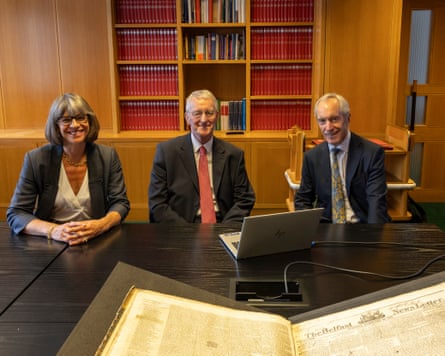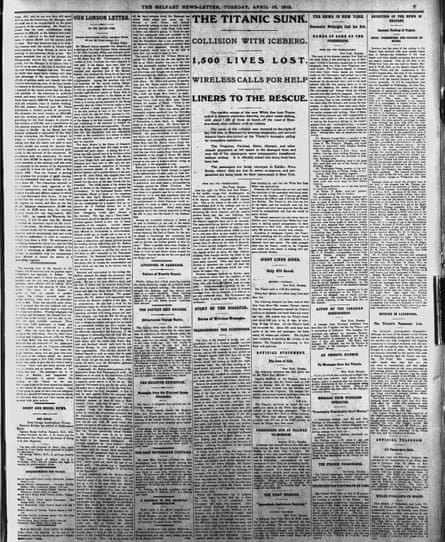There was a packed news agenda on 3 October 1738. The father of the notorious highwayman Dick Turpin had been arrested after being found with a stolen horse. Cannon fire rang out in St Petersburg to mark a Russian victory over the Ottoman Empire. In America, four families had been killed in Virginia in clashes with Native Americans. Meanwhile, a horse fell in the Thames at Westminster, nearly causing a drowning.
Welcome to the pages of the Belfast News Letter, where updates on the French Revolution run alongside adverts for brandy and the American Declaration of Independence was reported as a contemporary event.
The 3 October copy has a special place in newspaper history – it stakes a claim as the oldest surviving edition of the world’s longest continuously published English language daily newspaper. In fact, the paper is so old that it predates the UK’s switch to the Gregorian calendar. The edition would have been published on 14 October according to modern dating.
For the first time, the News Letter’s coverage of the most momentous events of the past three centuries can now be accessed free by anyone with a library pass or an online subscription, after the completion of a project to digitise its surviving editions. Everything from the Crimean war to the Troubles in Northern Ireland are covered, thanks to the joint project between the Northern Ireland Office, the British Library and online platform, Findmypast.
While the earliest editions are austere in appearance, Ben Lowry, the Belfast News Letter’s current editor, said they had many of the ingredients of the modern-day newspaper. “They look so severe that they’re like a reminder of an almost ancient age of poverty and hangings,” he said. “But actually, you see the genesis of newspapers in them. They’re full of fun. They have gossip. They have salacious stories.”
The first edition was probably published in 1737, some 60 years before the Act of Union and 175 years before the sinking of the Titanic, a major news event for a paper published in the city where the doomed liner was built.

The American Declaration of Independence, reproduced in its 27 August 1776 edition, featured alongside adverts for books, an appeal for a lost watch and a reward for finding a stolen horse – one guinea for finding it, or three for delivering the horse and thief. Adverts were the only items featuring illustrations at the time. Theft was denoted by woodcut prints of the devil.
It was once thought that its publication of the declaration was a Europe-wide scoop. The editor sneaked a peek at the document as it travelled to London via Northern Ireland – or so the story goes. Like other journalistic stories of triumph, it appears the tale may have grown in the telling. In truth, two London papers, the St James Chronicle and the General Evening Post, had already printed the historic text a week earlier.
While the paper was dominated by world events, even the oldest editions have examples of unusual yarns too good to leave out. The 20 April 1739 edition carried a lengthy piece about a marriage near Dunluce, County Antrim, at which the bride was so drunk she demanded to go to bed the moment the ceremony had been completed, only to fall and break her nose. She was later spotted in bed with a man who was not the groom.
The oldest surviving edition recounts the dramatic tale of an Italian woman who stabbed and killed a man who had been harassing her for 18 months.
The earliest copies ran across just two pages and were largely made up of letters from around the world, or material relayed from other sources. “There was a lot more censorship during this early period,” said Beth Gaskell, lead curator of news and moving image at the British Library. “There’s a bigger focus on international news and a lot of verbatim reporting of events. There’s less opinion because it was dangerous. But that doesn’t mean that you don’t get these kinds of really interesting stories.”
From 1789, the paper was dominated by the French Revolution, but the news could be a little on the slow side. In the days that followed the storming of the Bastille, an edition stated: “The French mails, which arrived this morning, brought little of consequence.”
However, accounts of the tumultuous events in Paris appeared later that month, including how “armed burghers paraded the city, attended by drums, beating to arms”, before giving accounts of the storming itself. It described the Bastille’s governor “holding out a white flag and opening one of the gates” before a party entered and were fired upon. It states the governor was later beheaded.
On Thursday 11 April 1912, the paper ran an enthusiastic if lowkey piece on the Titanic’s maiden voyage. “The departure yesterday from Southampton of the newest ocean giant, the Titanic, of the White Star Line, was an event that marks the last note of progress in modern shipbuilding,” it stated. “A large concourse of people had gathered to speed the vessel on her maiden voyage and she made an impressive picture as she quietly glided in brilliant sunshine.”
Just five days later, it ran what looked like a modern-day headline, albeit on page seven. “The Titanic sunk. Collision with iceberg,” it declared. “1,500 lives lost.” In a sign of the printing timeframes, the front page of the same edition ran an advert for White Star Line and its “triple screw” steamers, including the Titanic.

The Belfast News Letter was founded by Francis Joy, a lawyer and notary. His death was recorded in the paper in 1790, but he had the misfortune to die just as the paper carried a lengthy obituary of Benjamin Franklin, one of America’s founding fathers. Joy’s passing was given a single sentence.
Lowry said he had not “given up hope” that more of the oldest editions would be located, but said the new digital archive would open up the existing back catalogue to anyone wanting a glimpse into the past over their morning coffee. “It is thrilling,” he said. “It’s very important history, but above all, it’s very readable and enjoyable history.”

 3 months ago
69
3 months ago
69

















































